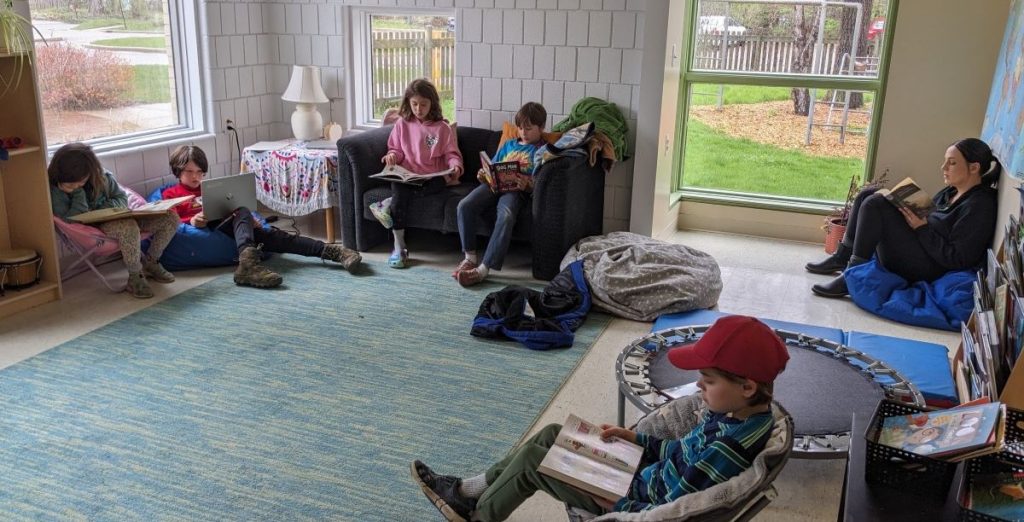Clonlara School offers a personalized approach to learning. This means that Clonlara families use a wide variety of methods; some use set curricula for their students, while others follow a self-directed learning approach. These self-directed learners may have very different experiences when it comes to learning to read!
In this blog post, Rosenrot Mireille Schülpke, Clonlara’s pedagogical research director, leads us through the research on how learning to read happens for the self-directed learner. She also gives us some practical ideas for supporting the development of reading skills in these students.
While some children develop an interest in letters and learn to read at the age of 5 or even earlier, others still show little motivation to do so at the age of 8. Families may start to worry in these cases, especially if they have not yet had much experience with their own child’s self-determined learning. But is there cause for concern?
Let’s see what the research says about self-directed students and learning to read.
Gina Riley on the Experiences of Former Unschoolers
Gina Riley, a professor at Hunter College of the City University of New York, may be known to some from her collaborative research projects with Peter Gray on unschooling. In 2018, she published a study on learning to read, “Exploring Unschoolers’ Experiences in Learning to Read: How Reading Happens Within the Self-Directed Learning Environment,” for which she conducted a survey of former unschoolers.
The study showed that, for all participants, learning to read took place in an age range from 3 years to the early teenage years. Like walking or talking, learning to read can happen naturally, especially if the child does not have a reading disability and if reading is present in the child’s natural environment through role models and available materials such as books. Most of the participants in the study, adult former unschoolers, reported being regular or occasional readers in later life. None of them had developed into non-readers.
The study also revealed a variety of different ways of learning to read. Some participants reported that they were taught basic skills such as first letters by a caregiver—either with formal teaching materials such as books or through informal, playful means such as Magic cards—and that they built on this knowledge later in a self-motivated way.
This motivation was very diverse. For some, curiosity played a role; for example, one participant wanted to find out in advance the next chapter of the book read to them by their mother. For others, there was a playful competitive spirit; for example, some wanted to learn to read faster than a sibling. In some cases, frustration also played a role in the motivation because peers could read and they themselves could not yet, but reading was seen as a desirable skill in the community. One participant reported that he practiced reading secretly at night because his younger sister was already better at it than he was. Other participants had simply identified reading as an important source of information that they wanted to use; for example, they needed to read the instructions for a video game.
Interestingly, some participants could not specifically remember a process of learning to read but rather remembered a sudden moment where everything fell into place: “I kinda remember trying to follow along while being read to, and I think one day it just kind of clicked,” reported one participant in the study.
Three out of 28 participants reported that they had found reading difficult to access and that it had been a struggle. But it cannot be denied that this could also be a realistic proportion for the number of people who experience these same struggles when being taught to read at school.
John Holt on Supporting Children in Learning to Read
John Holt, who coined the term “unschooling,” made many observations over the years about how young people learn to read without formal instruction. He also spoke to many parents and educators about their experiences. In his book Learning All the Time, Holt describes the experience of a teacher, Rasmus, who was responsible for teaching reading at a Danish independent school. The fact was that Rasmus did not do any reading exercises with the children at all, but simply read something together with them if they wanted to. He saw his main task as providing them with “a tiny amount of moral support.” In his experience, the majority of the children learned to read after a maximum of 30 hours spent reading together.
In a separate situation, Holt himself observed how a boy, without being prompted, began to lay out letters from elements he normally used to eagerly build play streets. This suggests that when letters and writing are present in the environment, children begin to recognize patterns in them and recreate them through play.
In this context, the psychologist and neuroscientist Ernst Pöppel speaks of action knowledge as one of three types of knowledge (alongside word knowledge and visual knowledge) that are linked together when learning to read. Action knowledge, which is what children are using when playing with words in the environment, is more intuitive and tends to be accompanied by emotions. Pöppel believes it is important that none of these three types of knowledge is valued more highly than the others.
Ernst Pöppel’s Critical View of Reading
Ernst Pöppel offers a critical view on reading at a time when there is growing concern about the apparent loss of reading activity among the younger generation.
In his article “Was geschieht beim Lesen,” Pöppel (2018) states that he does not share the concern about the disappearance of reading as a cultural technique because the human brain does not have the best prerequisites for it from the outset. He literally writes: “Reading is the most unnatural activity of all for the brain.”
According to Pöppel, the powerful cultural change is not happening now, in the form of a digital revolution, where reading activity in the population is decreasing; rather, it already happened when writing was developed and thus changed the entire thought process.
Pöppel believes that written knowledge detaches itself from direct communication and becomes more abstract. He even writes: “The human brain is virtually abused by reading . . . In this sense, I have no problem at all with modern technological developments that place greater emphasis on the visual representation of facts and that distance us from the overemphasis on reading as a cultural technique. With the help of new technology, a long abuse of the brain is being overcome.” Pöppel’s attitude is certainly radical but can also be very refreshing if you look at your own child’s everyday activities.
Writing Activities for Supporting the Development of Reading Skills
Because writing is also a motor activity and is easier for many children, it may make more sense for some children to learn to read by writing. This activity could be assigned to the area of action knowledge described by Pöppel.
There are many ways of integrating action knowledge into the learning process: Letters can be written on a large scale in the sand, laid out with a long thread as a shape, or scratched into a soft piece of clay. You can form letters out of modeling clay or dough with your hands, or trace them with your feet on a previously drawn chalk line.
It can also be helpful to first develop a feeling for the shape of the letters, which consist of straight and curved lines, by painting or drawing shapes in a playful, artistic way. This method comes from Waldorf education, which has developed a school subject called “form drawing.” Form drawing has proven its worth as a preparation for reading and writing for over 100 years.
As the research shows, there are many different ways to learn to read. If you followed a self-directed approach or are planning to, what advice or questions do you have for other families?








One Response
There is a phd research by Harriet Pattison. She studies how children learned to read when homeschooled/unschooled.